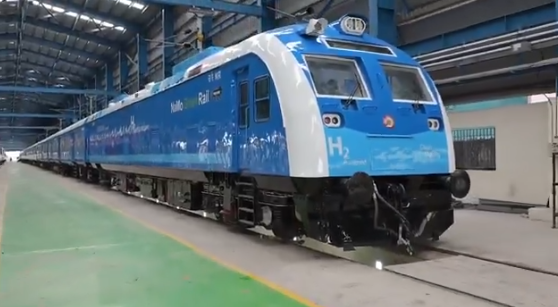India’s First Hydrogen-Powered Train Launched in Varanasi: A Green Revolution on Rails

In a landmark development signaling India’s commitment to sustainable transportation, Prime Minister Narendra Modi officially launched the country’s first hydrogen-powered train in Varanasi on October 16, 2025. This pioneering initiative marks a significant milestone in India’s journey toward adopting green technologies that can drastically reduce environmental pollution and dependency on fossil fuels.
The hydrogen train, developed through a collaboration between Indian Railways and leading technology partners, operates on hydrogen fuel cells that generate electricity by combining hydrogen and oxygen, emitting only water vapor as a byproduct. This innovation represents a clean alternative to conventional diesel engines that contribute heavily to air pollution and carbon emissions.
This launch aligns perfectly with India’s broader environmental goals, including the National Hydrogen Mission, aimed at positioning India as a global leader in clean energy solutions. According to experts, hydrogen-powered trains could potentially reduce carbon dioxide emissions by up to 80% compared to diesel locomotives. Given India’s vast railway network, the widespread adoption of such trains could significantly impact the country’s carbon footprint.
Operational details of the hydrogen train highlight its impressive efficiency. The train can travel over 800 kilometers on a single refueling, with refueling times comparable to diesel trains, ranging from 15 to 20 minutes. Importantly, the use of hydrogen fuel derived from renewable sources further enhances the ecological benefits of this technology.
Environmentalist activists have welcomed this initiative, emphasizing that transitioning to hydrogen trains is a proactive step towards tackling urban air pollution, especially in densely populated cities and industrial regions. Moreover, the train’s quieter operation will contribute to reducing noise pollution.
However, challenges remain in making hydrogen fuel infrastructure widely available across India and ensuring cost-effective production of green hydrogen. The government has announced plans to ramp up investments in hydrogen production facilities and secure partnerships with private entities to accelerate adoption.
In summary, the launch of India’s first hydrogen-powered train is a groundbreaking achievement that paves the way for a cleaner, more sustainable future for Indian Railways and the nation’s energy landscape. As Varanasi witnesses this historic moment, it sets an inspiring example for other countries looking to innovate and reduce carbon footprints in their transportation sectors.







